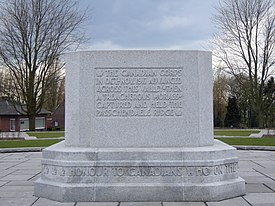Passchendaele Canadian Memorial
| Passchendaele Memorial | |
|---|---|
| Canada | |
 the Canadian Passchendaele Memorial | |
| For the Canadian Corps actions in the First World War during the Second Battle of Passchendaele in their taking and holding of Passchendaele village. | |
| Location | 50°53′52″N 3°0′48″E / 50.89778°N 3.01333°E near Passendale, Belgium on the site of the Crest Farm |
The Memorial's inscription reads: THE CANADIAN CORPS IN OCT.- NOV. 1917 ADVANCED ACROSS THIS VALLEY - THEN A TREACHEROUS MORASS - CAPTURED AND HELD THE PASSCHENDAELE RIDGE | |
The Passchendaele Memorial is a Canadian war memorial that commemorates the actions of the Canadian Corps in the Second Battle of Passchendaele of World War I. The memorial is located on the former site of Crest Farm, an objective captured by the 4th Canadian Division during the assault of 30 October 1917.[1]
The battle
The Second Battle of Passchendaele was the culminating and final attack of the Third Battle of Ypres during World War I. The battle took place in the Ypres Salient area of the Western Front, in and around the Belgian town of Passchendaele, between 26 October 1917 and 10 November 1917. The Canadian Corps was tasked with relieving the exhausted II Anzac Corps, continuing the advance started with the First Battle of Passchendaele and ultimately capturing the town of Passchendaele itself.[2]
In the low ground west of the Passchendaele Ridge three months of constant shelling had blocked the watercourses that normally provided drainage. When rain began falling, the battlefield was transformed into a quagmire of mud making movement extremely difficult.[3] The mud was to become one of the defining features of the battle for soldiers on both sides, and did a great deal to hamper offensive operations.
The Canadian Corps operation was executed in series of three attacks each with limited objectives, delivered at intervals of three or more days. The execution dates of the phases were tentatively given as 26 October, 30 October and 6 November, with a smaller action later executed on 10 November.[4] The attack was successful in capturing the German-held high ground along the Passchendaele-Westrozebeke ridge but the campaign was forced to end just short of Westrozebeke itself.[5] The Second Battle of Passchendaele cost the Canadian Corps 15 654 casualties with over 4 000 dead, in 16 days of fighting. Nine Victoria Crosses, the highest military decoration for valour awarded to British and Commonwealth forces, were awarded to Canadians for actions during the battle.
Monument
Location & Design
The Passchendaele Memorial site is a small keyhole shaped park located on the aptly named 'Canadalaan' on the southwest fringe of Passendale village. Fittingly, maple trees and a hedge of holly line the edges of the park and well kept lawns and stone pathways surround the low circular flagstone terrace that the granite memorial block rests on. From the centre of the memorial grounds one can see, down a long avenue of trees, the rebuilt spires of Ypres.[6]
Selection
At the end of the war, The Imperial War Graves Commission granted Canada 8 sites, 3 in France and 5 in Belgium, on which to erect memorials. Each site represented a significant Canadian engagement and for this reason it was originally decided that each battlefield would be treated equally and graced with identical monuments.[7] The Canadian Battlefields Memorials Commission was formed in November 1920 to discuss the process and conditions for holding a memorial competition for the European sites.[8] In October 1922, the submission of Toronto sculptor and designer Walter Seymour Allward was selected as the winner of the competition, and the submission of Frederick Chapman Clemesha placing second. The commission selected Vimy Ridge in France as the preferred site of Allward's design.[9] Clemesha's Brooding Soldier design was selected for the remaining sites but was later, for a number of reasons, erected only at St Julien, Langemarck in Belgium. The remaining sites receiving similar simple commemorative granite block inscribed with a brief description of the battle in both English and French.
Passchendaele had been Canadian Corps Commander General Arthur Currie's choice for the site on which the National Memorial should have been built upon. However he was overruled and the National Memorial was built on Vimy Ridge instead.[10]
Notes
- ^ Nicholson p. 321
- ^ Bean 929
- ^ Nicholson p. 311
- ^ Nicholson 314
- ^ Bean p. 936
- ^ Jacqueline Hucker (2012). "Monuments of the First and Second World Wars". The Canadian Encyclopedia. Historica Foundation. Retrieved 2012-07-26.
- ^ Busch, Briton Cooper (2003). Canada and the Great War: Western Front Association Papers. Montreal: McGill-Queen's University Press. ISBN 0-7735-2570-X. 205
- ^ "Design Competition". Veteran Affairs Canada. 2007-03-25. Retrieved 2008-01-12.
- ^ Vance, Jonathan Franklin (1997). Death So Noble: Memory, Meaning, and the First World War. Vancouver: UBC Press. ISBN 0-7748-0600-1. 66–69
- ^ "Vimy Ridge: The making of a myth". The Globe and Mail. Toronto. 31 March 2009.
References
- Bean, C.E.W. (1941). The Official History of Australia in the War of 1914-1918: Volume IV: The A.I.F. in France 1917 (11th ed.). Sydney: Halstead Press Pty Limited.
- Nicholson, Gerald W. L. (1962). Official History of the Canadian Army in the First World War: Canadian Expeditionary Force 1914–1919. Ottawa: Queen's Printer and Controller of Stationary.
